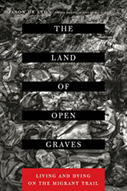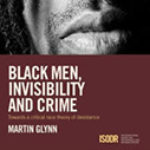THE LAND OF OPEN GRAVES: LIVING AND DYING ON THE MIGRANT TRAIL

Author: Jason De León
Publisher: Berkeley, CA: University of California Press, 2015. 384p.
Reviewer: Susan Bibler Coutin | January 2017
Everyone should read this book. The Land of Open Graves recounts in graphic detail the results of U.S. border control policies in terms of human suffering and lives lost. Readers will learn about the hopes and aspirations of border crossers, the challenges that they encounter, and the physicality of crossing under current enforcement conditions, which push migrants into deadly terrain that leaves its marks on survivors’ bodies and psyches. Regardless of one’s stance on immigration and border enforcement, it is important to be aware of the ways that border crossers, many of whom feel they have no alternative, are impacted by current practices.
Yet, reading The Land of Open Graves is difficult. Not because of the writing style, which is engaging, but rather because the book forces an encounter with subjects many might prefer to avoid: the ways that bodies decay when they are abandoned in the desert, the role that vultures and insects play in the decomposition process, the speed with which human remains are scattered by the elements, the tremendous costs of the international immigration order, and the fact that those who experience these costs are actually human beings. The book also covers lighter topics, such as the humor with which would-be migrants attempt to dissipate the tension that surrounds their journey. What stands out, however, is the degree to which De León introduces readers to a world that they likely either do not know or wish they could forget.
The Land of Open Graves takes as its central focus the impacts of “Prevention through Deterrence” policies that the United States adopted in 1993. These policies deploy the terrain itself as a weapon in the militarization of the U.S.-Mexico border. Basically, U.S. border patrol agents heavily police portions of the border where walking is reasonably feasible, forcing illicit crossers into remote areas where the heat is intense, water is scarce, and plant and animal life are threatening. In theory, displacing border crossers results in fewer unauthorized migrants, as heightened risks deter would be crossers. In practice, De León found, the forces that propel movement are so powerful that individuals assume these risks, hoping to make it to the United States. The result is a rising body count along the border, and greater suffering on the part of all who make the attempt.
De León’s analysis of Prevention through Deterrence is based on archaeological study of the articles that crossers leave behind in the desert, forensic analysis of bodies, ethnographic fieldwork within migrant shelters, and interviews with migrants, their family members, and Mexican and U.S. authorities. Indeed, a key point made by the book is that it is productive to combine archaeology and sociocultural anthropology. Archaeological tools make it possible to study migrants’ lives through the traces that they leave behind – backpacks filled with food, a discarded shoe, identity documents. And ethnographic approaches provide insight into migrants’ thoughts, sentiments, and experiences. De León writes, “A focus on the material traces of ongoing contested social phenomena … can provide fresh perspectives distinct from the dominant narratives often written by those in power” (p. 172).
Theoretically, the book makes several important contributions. De León draws on notions of structural violence to argue that there are nonhuman actors (such as the desert terrain and wildlife) involved in immigration law enforcement, and that the ways that individuals die can reflect their social position. Thus, when animals eat the bodies of would-be border crossers, he attributes this outcome to Prevention through Deterrence policies while also noting that the horrific nature of such a demise indicates the dehumanization to which migrants are subjected. Drawing on work by Michel Callon and John Law, he suggests that in this example, agency is exerted by a collection of human and nonhuman actors that he refers to as a hybrid collectif. He also develops the notions of necroviolence to refer to “violence performed through the specific treatment of corpses” in ways that are offensive (p. 69). Necroviolence, he notes, can be aimed at the living (by horrifying them) while also enabling the powerful to deny responsibility for death. Therefore, he insists, the ways that bodies decompose are political. This is an important point. Not everyone thinks about what happens to the bodies of those who die crossing the U.S.-Mexico border.
Some readers will likely wonder about the ethics of this research and of the account that De León produces. For example, in order to study the decomposition process, De León and his assistants killed a pig, dressed the pig’s body in human clothing, put a piece of paper in the pig’s pocket (as many migrants hide a paper with their name in hopes that their bodies will be identifiable if they perish), and left it in the shade of a tree for two weeks with cameras running. He was thus able to show that the bodily remains were scattered quickly and that the piece of paper disappeared. Some readers may consider it unethical to have killed the pig, and may find the human-pig comparison offensive. Another controversial aspect of the research is that De León chose to include a photograph of the body of Maricela, a deceased woman that his research team found. He also traced her identity, visited her relatives in her home country, and included photos and an account of her relatives’ struggle to accept her death. In response to criticisms, De León argues that his book serves as both a testimony and an obituary, and that her relatives wanted her story told. Regardless of what one thinks of the ethics involved, the resulting account of both Maricela and of a young man – José Tacuri – who disappeared en route to the United States is haunting.
A word regarding the text and photographs is in order: both are riveting. The book is written in a conversational, relatively informal, style, which De León characterizes as a deliberate attempt to challenge an “often sterile anthropological discussion about Latino migration” (p. 14). The book is filled with photographs, many of them taken by Michael Wells, depicting landscapes, bones, injuries, migrant encampments, journeys, spaces, families, and the objects – such as a disintegrating shoe that had been repaired by a bra strap — that migrants leave behind. De León argues that by doing fieldwork in migrant shelters and along the routes that migrants travel – though he did not actually accompany them on a crossing – he is able to capture facets of experience that are left out of the after-the-fact narratives that many researchers obtain through interviews. In particular, he is able to record “humor, expletives, subtle forms of irony, and self-deprecation” which he suggests are “key elements of Mexican working-class subjectivity” and “important forms of resistance and migrant identity construction” (p. 92). A good portion of the book follows the journey of two friends – Memo and Lucho – that De León met at a shelter in Mexico. He includes lengthy excerpts of his conversations with them and with other individuals whom he met in the course of his research, arguing that it is important to include the voices of migrants themselves. He also gave Memo and Lucho a camera so that they could document their own border journey. Some of the published photos were taken by them.
The book does not end, as one might imagine, with policy recommendations. Rather, De León stresses the broader, structural nature of the factors that propel both movement and heightened enforcement. He writes, “In the end, it comes down to the United States’ need for cheap labor that can easily be controlled with the threat of deportation and the duplicitous stance that we don’t want undocumented laborers in our country. The American public has to first recognize and resolve this fundamental socioeconomic conundrum before any serious immigration policy reform can take place” (p. 284).
The Land of Open Graves would likely be appropriate for criminal law and criminal justice courses that cover immigration policies, enforcement practices, borders, research ethics, Chicano Studies, Latin American Studies, and the nexus between archaeology and sociocultural anthropology. Some students may find the content difficult to read, however, so discussions will need to be handled with sensitivity.
Professor, Criminology, Law and Society and Anthropology, University of California, Irvine


